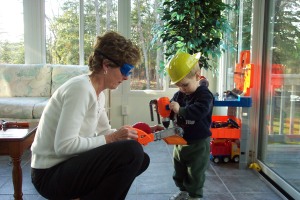
Do your kids ever get tired of the same activities during therapy or even while playing? Well one of the ways I’ve tried to spice things up is by adding in obstacle courses. Generally I take the same skills we’ve been working on and put them all together. For the older kids I let them help me create the order and the items that are in the course. The great thing is you can put as many or as few items as you want in it and if the kids are helping you they will most likely pick an activity that you regularly work on! In addition to working on the individual skills it also helps them work on sequencing and transitioning from one task to the next. Add in a stop watch and you can make it a lot of fun! Usually the first effort is the slowest because they are figuring out what’s next and how to do each skill so they generally ‘beat’ their time on the next round. You can really spice it up by using dice to see how many times they have to do the entire course and/or how many times they have to do each item in the task. We have made indoor and outdoor obstacle courses and sometimes a combination of both!
Here are some ideas that I have used recently:
Outdoors – ride bike a certain distance, run to the play structure, traverse the monkey bars (after climbing up the ladder), climb up the climbing wall/ladder, go down the slide, walk on the ledge separating the grass from the bark (balance beam), and skip back to the bike.
Indoors – hopping on right foot on dots, jump rope, hopscotch one way, jumping jacks, animal walk out and back (bear, cat, snake, frog, etc), hopscotch back, jump rope, hop on left foot on dots
Some indoor variations – add in knee walking (I have them pretend they are a choo choo train), set up cones and have them heel walk while zig zagging one direction and toe walk while zig zagging back, step up onto a step stool and step down or hop up and hop down, do a forward roll, crawl through a tunnel, climb over a stack of cushions, hop like a bunny, step from one step stool to the next or one phone book to the next, walk on a tape line, and many more
Some outdoor variations – bounce a ball in place or moving, kick a ball (for distance or into a goal/target), walk backwards on a curb/ledge, climb down a ladder, crawl in the grass, ride a scooter instead of a bike or ride a tricycle, carry a plastic egg on a spoon, hop in a potato sack (you can buy fun kid ones now or you can use extra large pillow cases), run zig zag through cones
Another idea is a fine motor obstacle course or a combination of both. You can create fine motor stations and they have to do gross motor activities to get between each one!
These are just a few of the ideas I have used. I would love to hear some of your ideas!










